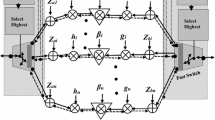Abstract
In this paper, we study the bidirectional/two-way relaying while considering dual antennas at the relay. With detect-and-forward relaying, we propose a transmit beamforming scheme using equal gain transmission (EGT) principle in the bidirectional relaying. Analytical outage probability and symbol error probability for the proposed scheme are presented and a close match with the numerical results is observed. Through numerical results, we show that EGT based transmit beamforming performs slightly worse than the optimum transmit beamforming scheme, while EGT is simpler to implement and requires partial channel state information (CSI). We also show that EGT based transmit beamforming outperforms existing transmission schemes in the presence of CSI error .






Similar content being viewed by others
Notes
Note that [5] presented DF bidirectional relaying using single relay antenna while utilizing error correcting codes. In contrast, this paper does not consider error correcting codes.
In other words, the relay estimates \(x_A\) correctly. Note that only the analytical results adopt the assumption of perfect self interference cancellation. Despite this assumption, we show in Sect. 5 that the analytical results match closely with the simulation results, hence the probability of cancellation error is negligible.
References
Zhang, S., Liew, S. C., & Lam, P. P. (2006) . Physical-layer network coding. In Proceedings of the IEEE conference on mobile communications (MobiComm’2006) (pp. 358–365).
Popovski, P., & Yomo, H. (2007). Physical network coding in two-way wireless relay channels. In Proceedings of the IEEE international conference on communication (ICC) (pp. 707–712).
Katti, S., Gollakota, S., & Katabi, D. (2007). Embracing wireless interference: Analog network coding. SIGCOMM Computer Communiaction Review, 37(4), 397–408. doi:10.1145/1282427.1282425.
Yuen, C., Chin, W. H., Guan, Y. L., Chen, W., & Tee, T. (2008). Bi-directional multi-antenna relay communications with wireless network coding. In IEEE vehicular technology conference (pp. 1385–1388).
Zhang, S., & Liew, S. C. (2009). Channel coding and decoding in a relay system operated with physical-layer network coding. IEEE Journal on Selected Areas in Communications, 27(5), 788–796.
Eslamifar, M., Chin, W. H., Yuen, C., & Guan, Y. L. (2012). Performance analysis of two-step bi-directional relaying with multiple antennas. IEEE Transactions on Wireless Communications, 11(12), 4237–4242.
Love, D. J., & Heath, R. W. (2003). Equal gain transmission in multiple-input multiple-output wireless systems. IEEE Transactions on Communications, 51(7), 1102–1110.
Simon, M. K., & Alouini, M. S. (1939). Digital communication over fading channels. New Jersey: Wiley.
Larsson, E. G., & Stoica, P. (2003). Space-time block coding for wireless communications. Cambridge: Cambridge University Press.
Papoulis, A., & Pillai, S. U. (2002). Probability, random variables and stochastic processes. New York City: McGraw Hill Press.
Qi, X., Alouini, M. S., & Ko, Y.-C. (2003). Closed-form analysis of dual-diversity equal-gain combining over rayleigh fading channels. IEEE Transactions on Wireless Communications, 2(6), 1120–1125.
Wu, Y., & Patzold, M., (2009). Performance analysis of cooperative communication systems with imperfect channel estimation. In IEEE international conference on communications (pp. 1–6).
Lim, A., & Lau, V. K. N. (2008). On the fundamental tradeoff of spatial diversity and spatial multiplexing of MISO/SIMO links with imperfect CSIT. IEEE Transactions on Wireless Communications, 7(1), 110–117.
Author information
Authors and Affiliations
Corresponding author
Additional information
This work was supported by the NTU-NXP Intelligent Transport System Test-Bed Living Lab Fund S15-1105-RF-LLF from the Economic Development Board, Singapore.
Rights and permissions
About this article
Cite this article
Noor-A-Rahim, M., Guan, Y.L. A New Transmit Beamforming Scheme for Bidirectional Relaying. Wireless Pers Commun 97, 5929–5939 (2017). https://doi.org/10.1007/s11277-017-4819-6
Published:
Issue Date:
DOI: https://doi.org/10.1007/s11277-017-4819-6




